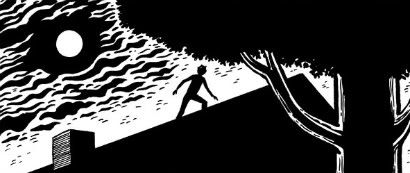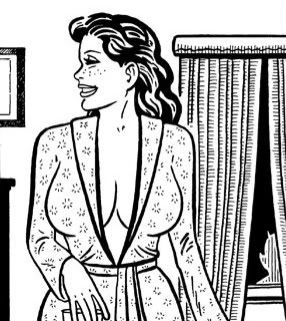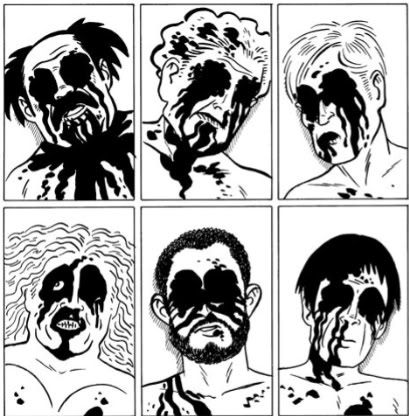How shall he appear?
Speak of the Devil #1-6 (of 6)

This is Gilbert Hernandez's newest project, a bimonthly Dark Horse miniseries, which just wrapped its serialization this past week. I expect a book collection will appear at some point, although none has been solicited yet.
This is an odd series in several ways. It first arrived in stores a year ago with virtully no fanfare -- I didn't even know it existed until the first issue showed up on its week's release list -- hot on the heels of Hernandez's stated desire to avoid serializing comics stories. Its title page bears the dates "2006-7," so it could have simply been started before its artist got the desire to move into mainly self-contained works, but it also serves as part of a then-announced series of works otherwise restricted to the graphic novel format and published by Fantagraphics. Among that number are Chance in Hell -- my pick for best comic of 2007 -- and the upcoming The Troublemakers, comics conceived as 'adaptations' of movies that exist inside Hernandez's Love and Rockets universe, all of them featuring the acting talents of his character Fritz.
The slightest comparison of Chance in Hell to this present work reveals the many approaches an artist can take, given the concept. Hernandez himself described Chance in Hell as Fritz's first role and her only "art film," and the 'filmic' nature of the book mainly plays itself out in capturing the texture of a certain type of seething, arthouse-grindhouse picture, a not necessarily high-minded but certainly thought-out thing determined to produce visions of societal decay while juggling enough exploitable elements to put together a nice trailer. There's even a take on ye olde three-act structure, with each of the book's three sections set up as encapsulations of a particular period in its protagonist's life, the narrative swinging back and forth, darting between the weeks and across locations, furiously creating suggestion through the gaps between panels.
Because it is a comic, and such heated scene-shifting is not new to Gilbert Hernandez. Luckily, his talent is varied enough so as to direct multiple features.

Speak of the Devil is a different kind of comic. Its movielike nature is far more obvious, in that Hernandez loads early sections of the story up with long panels and looming vistas - real widescreen comics. That actually made it all seem even more perverse a choice for serialization; if you're going to have some of your projects go straight to the bookshelf, then surely a top choice would be the airy story that might seem insubstantial in 20-page bites!
It's also a different kind of film - the arthouse done with, we're now given a straight-up sleaze quickie, a grotty sex thriller wherein the high school gymnastics team is a hotbed of lesbian desire, suburban couples don't mind leaving the bedroom window cracked for the local peeping tom, and there's never an inappropriate time to cut away to a well-endowed woman in a slinky devil costume.
But this isn't so much an explicit comic/movie as a grimy one - if I had to place it at some point in the exploitation movie timeline, it'd have to be a mid-'60s piece, prior to the loosening of sexual content restrictions that disallowed much conjoining of nudity and sexual contact, but obviously well after the dam was blown on explicit violence. I doubt any of that matches up with the Palomar timeline Hernandez's stories use, nor does the presentation even quite synch up with reality -- I think there'd still be a bit too much sex in here to mix lightly with the level of violence Hernandez eventually whips up -- but the evocation is there, coyly matching up with a level of explicit content that I suspect Dark Horse would be comfortable with.

And yeah - the grime comes through. The aforementioned suburban exhibitionists are Walter and Linda, newly-married and very horny, and the peeping tom is none other than Walter's daughter from a prior marriage, the athletic Val. It may be Linda that wears the sexy devil costume for work, but Val dressed in her own grinning demon ensemble to leap across rooftops and stare into windows, and there's no pair of drapes she likes to part more than Linda's, particularly when she's in the act with Val's dear father.
But Val is also just a girl, and hungry for the affection of Paul, a moody boy at school who likes to hang around in graveyards and ponder The Dark Secrets of Society. Val thinks he might be gay -- she knows that's true of her worshipful gymnastics pal Patty, and rather enjoys the one-sided attraction -- but what really gets him off is crossing the threshold of acceptability, something he likes to think about but Val does on a regular basis. And once one boundary's broken, what's a few more?

Yes, murder -- mass murder -- soon develops, as several impolite members of society lash out. But it'd do the reader good to pay attention to who's always wielding the knife, who never stops pondering things and making up stores, and who merely enjoys being an accessory to cruelty. There's many assaults on peering eyes here -- good, low-rent shorthand Hitchcock/Peeping Tom -- and all the difference is made in how much looking gives way to doing.
Yet while this project is certainly more of a lark than Chance in Hell -- there's some massively, knowingly rank dialogue, and the final chapter contains no less than two gymnastics-themed killings -- nothing ever stays very steady in a Gilbert Hernandez work. Just look at his last Dark Horse project, 1996's Girl Crazy, which started out as a slapstick t&a pulp-fusion superheroine story and ended up as a gore-drenched will-to-power fable, with additional slapstick.
Likewise, Speak of the Devil eventually takes on an oddly lyrical tone, the off-the-cuff beauty than can be grasped by films forced to squeeze every drop of value out of natural environments, away from the possibility of studio quality as it is understood. Chapter five in particular is a bravura, funny-sad account of murders gone right, murders gone wrong, carjacking, bed-hopping, heads flying and teenagers who just can't help falling in love, ready to expand crushes and jealousies into a proper, public portrait of all the aching they feel inside.
Because people like Val may wear masks, but they only hide things in plain sight.

It goes without saying that the visuals are top-notch; Hernandez tosses in all sorts of great, subtle visual tricks, like having a speaking character stand off-panel when another character isn't listening, or deliberately erasing his female characters' full figures when they're dressed as ghouls of the night. The eyes of Beto's devil mask are always open, and by the end of the story they compliment the open eyes of the dead, at least when the dead don't have their eyes forcibly removed - it's telling that the only corpses with whole, peering eyes are those who went a little further in the book's staring contest, fated to glare forever!
Another fine touch in a story filled with them, detailed in both its jokey premise (there's even an Evil Lives On twist ending!), and its character observation. Speak of the Devil may look like a 'perversity in suburbia' type of thing, but in action it's more of a portrait of youths and adults caught up in more primal desires -- for adventure, affection, attention -- with only one of them actually immature enough to act on everything, the rest content to live semi-vicariously by egging the actor on. They do speak the devil's name, but it's the devil that's eventually saddest, most damned and doomed.

This is Gilbert Hernandez's newest project, a bimonthly Dark Horse miniseries, which just wrapped its serialization this past week. I expect a book collection will appear at some point, although none has been solicited yet.
This is an odd series in several ways. It first arrived in stores a year ago with virtully no fanfare -- I didn't even know it existed until the first issue showed up on its week's release list -- hot on the heels of Hernandez's stated desire to avoid serializing comics stories. Its title page bears the dates "2006-7," so it could have simply been started before its artist got the desire to move into mainly self-contained works, but it also serves as part of a then-announced series of works otherwise restricted to the graphic novel format and published by Fantagraphics. Among that number are Chance in Hell -- my pick for best comic of 2007 -- and the upcoming The Troublemakers, comics conceived as 'adaptations' of movies that exist inside Hernandez's Love and Rockets universe, all of them featuring the acting talents of his character Fritz.
The slightest comparison of Chance in Hell to this present work reveals the many approaches an artist can take, given the concept. Hernandez himself described Chance in Hell as Fritz's first role and her only "art film," and the 'filmic' nature of the book mainly plays itself out in capturing the texture of a certain type of seething, arthouse-grindhouse picture, a not necessarily high-minded but certainly thought-out thing determined to produce visions of societal decay while juggling enough exploitable elements to put together a nice trailer. There's even a take on ye olde three-act structure, with each of the book's three sections set up as encapsulations of a particular period in its protagonist's life, the narrative swinging back and forth, darting between the weeks and across locations, furiously creating suggestion through the gaps between panels.
Because it is a comic, and such heated scene-shifting is not new to Gilbert Hernandez. Luckily, his talent is varied enough so as to direct multiple features.

Speak of the Devil is a different kind of comic. Its movielike nature is far more obvious, in that Hernandez loads early sections of the story up with long panels and looming vistas - real widescreen comics. That actually made it all seem even more perverse a choice for serialization; if you're going to have some of your projects go straight to the bookshelf, then surely a top choice would be the airy story that might seem insubstantial in 20-page bites!
It's also a different kind of film - the arthouse done with, we're now given a straight-up sleaze quickie, a grotty sex thriller wherein the high school gymnastics team is a hotbed of lesbian desire, suburban couples don't mind leaving the bedroom window cracked for the local peeping tom, and there's never an inappropriate time to cut away to a well-endowed woman in a slinky devil costume.
But this isn't so much an explicit comic/movie as a grimy one - if I had to place it at some point in the exploitation movie timeline, it'd have to be a mid-'60s piece, prior to the loosening of sexual content restrictions that disallowed much conjoining of nudity and sexual contact, but obviously well after the dam was blown on explicit violence. I doubt any of that matches up with the Palomar timeline Hernandez's stories use, nor does the presentation even quite synch up with reality -- I think there'd still be a bit too much sex in here to mix lightly with the level of violence Hernandez eventually whips up -- but the evocation is there, coyly matching up with a level of explicit content that I suspect Dark Horse would be comfortable with.

And yeah - the grime comes through. The aforementioned suburban exhibitionists are Walter and Linda, newly-married and very horny, and the peeping tom is none other than Walter's daughter from a prior marriage, the athletic Val. It may be Linda that wears the sexy devil costume for work, but Val dressed in her own grinning demon ensemble to leap across rooftops and stare into windows, and there's no pair of drapes she likes to part more than Linda's, particularly when she's in the act with Val's dear father.
But Val is also just a girl, and hungry for the affection of Paul, a moody boy at school who likes to hang around in graveyards and ponder The Dark Secrets of Society. Val thinks he might be gay -- she knows that's true of her worshipful gymnastics pal Patty, and rather enjoys the one-sided attraction -- but what really gets him off is crossing the threshold of acceptability, something he likes to think about but Val does on a regular basis. And once one boundary's broken, what's a few more?

Yes, murder -- mass murder -- soon develops, as several impolite members of society lash out. But it'd do the reader good to pay attention to who's always wielding the knife, who never stops pondering things and making up stores, and who merely enjoys being an accessory to cruelty. There's many assaults on peering eyes here -- good, low-rent shorthand Hitchcock/Peeping Tom -- and all the difference is made in how much looking gives way to doing.
Yet while this project is certainly more of a lark than Chance in Hell -- there's some massively, knowingly rank dialogue, and the final chapter contains no less than two gymnastics-themed killings -- nothing ever stays very steady in a Gilbert Hernandez work. Just look at his last Dark Horse project, 1996's Girl Crazy, which started out as a slapstick t&a pulp-fusion superheroine story and ended up as a gore-drenched will-to-power fable, with additional slapstick.
Likewise, Speak of the Devil eventually takes on an oddly lyrical tone, the off-the-cuff beauty than can be grasped by films forced to squeeze every drop of value out of natural environments, away from the possibility of studio quality as it is understood. Chapter five in particular is a bravura, funny-sad account of murders gone right, murders gone wrong, carjacking, bed-hopping, heads flying and teenagers who just can't help falling in love, ready to expand crushes and jealousies into a proper, public portrait of all the aching they feel inside.
Because people like Val may wear masks, but they only hide things in plain sight.

It goes without saying that the visuals are top-notch; Hernandez tosses in all sorts of great, subtle visual tricks, like having a speaking character stand off-panel when another character isn't listening, or deliberately erasing his female characters' full figures when they're dressed as ghouls of the night. The eyes of Beto's devil mask are always open, and by the end of the story they compliment the open eyes of the dead, at least when the dead don't have their eyes forcibly removed - it's telling that the only corpses with whole, peering eyes are those who went a little further in the book's staring contest, fated to glare forever!
Another fine touch in a story filled with them, detailed in both its jokey premise (there's even an Evil Lives On twist ending!), and its character observation. Speak of the Devil may look like a 'perversity in suburbia' type of thing, but in action it's more of a portrait of youths and adults caught up in more primal desires -- for adventure, affection, attention -- with only one of them actually immature enough to act on everything, the rest content to live semi-vicariously by egging the actor on. They do speak the devil's name, but it's the devil that's eventually saddest, most damned and doomed.

<< Home